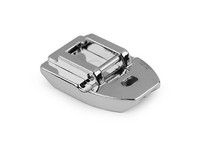Zippers are available in different levels of durability and utilize different types of materials. Certain materials are known for being more heavy duty and durable than the others but each will have specific products where they are used often and succeed at their role.

Metal zippers are a symbol of quality. The teeth were molded and placed on both sides of the tape in a way that when the zipper closed, the teeth would fit together firmly like a puzzle. They are used on a variety of items, such as pants, sweatshirts or smaller bags and wallets and are available in multiple finishes. The Most common finished are aluminum, brass, antique brass and black oxidized.

A zipper with molded plastic teeth is similar to that of a zipper made of metal teeth with the only difference being the teeth are molded out of plastic. These teeth are manufactured with high-performance resins making them extremely strong resulting in very durable and flexible zippers. Molded plastic zippers are ideal for most outdoor products and are especially common in outerwear.

These are the most common types of zipper teeth because they are lightweight, rustproof and heat resistant. Although they were originally made using nylon, nowadays, they are more typically made from polyester. Coil zipper teeth are used on a variety of products from wallets and purses and occasionally on some clothing items. Often sold per meter, it is easy to cut and adjust to any size.
 |
CAUTION! When washing, always close the zippers. Reason? For once, you will extend the life of the zipper itself, and second it will not damage some other pieces of laundry. |
There are five common types of zippers that can be found on a range of products in your every day life. Below are the names of each type of zipper as well as their most common uses:

Commonly found on jackets, vests and other outerwear, a separating zipper allows both side of the tape to come apart completely when the zipper is fully undone.

This type of zipper does not separate at the bottom. Usage: trousers, boots, pockets.

This type of zipper in the continuous piece is suitable wherever you need a zipper in above standard length. Usage: manufacture of tents, sleeping bags, ski bags. You can also use it for suitcases, backpacks and handbags.
...that sliders could have these functions: autolock, pinlock and non-lock? Autolock - the lock automatically locks when no force is placed on the tab-pull. Used in clothing, sportswear, outerwear, jackets, skirts, dresses, etc. Pinlock - pins on the pull-tab work on the elements and lock. Most commonly used in jeans and trousers. Non-lock - the pull-tab does not lock at any position on the body. No locking mechanism. Used for bags, handbags, luggage, tents, bedding, etc.

 |
TIP! What to do when the zipper gets stuck? Just use an ordinary pencil! Simply use the pencil / draw on the zipper teeth along the entire length. Done, it should work now |
 |
Zippers are closed and opened with metal sliders that you can take in different colors and shapes. |
 |
Zipper loops are used for better grip on the zipper. In addition, they can serve as decorative pendants. |
 |
The zipper stops are necessary so the slider does not come out. Its application is very easy, just squeeze it with pliers. |
 |
The elegant metal ending can then be used on the zipper end, mostly for handbags or bags. |
 |
To easily apply slider on nylon zipper we have this handy tool. |
 |
If you sew an invisible zipper, you will appreciate this special zipper foot that holds the zipper in the same place during sewing. |